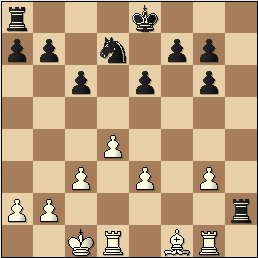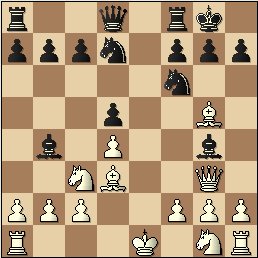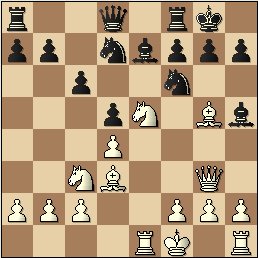


#1. - Black to Move
What do you do with your King and why?
Take a look at the following three positions, review the questions and spend 5-10 minutes considering your answers.
 |
 |
 |
|
#1. - Black to Move |
#2. - Black to Move | #3. - White to Move |
In each of the above examples:
Whose position you prefer and why?
What would you do with the King (#1 and #2 - Black, #3 - White)?
STOP - answers are below.
========================================================================
In almost every game we have to deal with the question – "What to do with the King?"
The basic concept is to castle as soon as you can. Why? Well, the purpose of castling is to get the R in the game and to get the K in a safer position. And the bonus – you move two pieces at once.
Well, as you advance your skills you certainly should be looking for a better reasoning and for pointers that would help you to make a decision.
The above 3 quick examples are from the recent game of my adult student who is rapidly progressing and is now rated around 1400 (Examples #1 and #2), and from my game against GM Gregory Kaidanov from the Invitational US Championship 1995.
Let’s start with example #1.
Black has advantage – he has an extra pawn and White has no compensation. Since this is an Endgame, the first option for Black K I would consider is 19…Ke7. Note that it is an ideal spot for the K –
The K is safe – protected by the Ps, White B can’t create any threats.
The K is also close to the center and equally distant from the Q-side and K-side. With so few pieces left, I would be thinking that likely if one pair of Rs is gone (certainly if all Rs are gone) the K will start his advancement into the enemy territory.
In the game, Black played 19…0-0-0?!, and after 20.Bd3 Nf6 21. Rdf1 reached a position from the Example #2.
Example #2.
Black still has a solid advantage, but it is not easy to find an active plan. This is because the White Rf1 is pinning the Nf6. Once Black realized that the Pf7 needs protection, he made a correct adjustment.
The K is not only a target or an attacker. The K is also a solid defender. Black's best assignment for the K is to go to e7 to protect Pf7 and free the N.
One of the key rules of many static endgames is “No Rush.” Once Black realized that he made a mistake on move 19….0-0-0?!, he correctly adjusted his strategy and played 21…Kd7! Eventually the K made it’s way to e7 on move 26, some 7 moves later that it should have (19…Ke7 in Example #1). However, it is better later than never and Black went on to win the game.
Example #3 is from my 1st game in my very first US championship. This was round robin invitational; I was to face the top 13 players in the country in 1995. My opponent is a super GM, who in 1995 won several of the major tournaments in US.
The position is nearly equal, with White holding a minimal advantage due to some pressure on the K-side. The open e-file is certainly a bad place for my K.
As I was considering what to do about my K, I immediately dismissed a future long castle because my K will be in danger on the Q-side. I got very little piece protection there. Black could possibly mess-up my pawns with Bxc3, after a timely Pc7-c5, Q could join the attack (Qa5 or Qb6) also the c-file could be opened for his Rs.
I do have some pressure on the K-side with several of my pieces controlling a lot of space there. My K will feel very safe there protected by the pawns and pieces. Thus, the decision was made, but what about the execution? Well, after 9.Nf3 or 9.Nge2 and a future 0-0, what would my plan be? Double up on the e-file, trade the Rs there, trade some minor pieces, and Draw is almost certain. I decided that the Rh1 would be much more productive if it remained on h1 and supported the advancement of my Pawn-h.
|
So, I played 9.Kf1! My K is safe on f1, and, if necessary could go to g1. My Rh1 will be active on h-file or can get out via Rh3-g3. The game continued 9…Pc6 10. Nf3 Bh5 11.Ne5 Be7 12.Re1.
Consider this position with the one 3 moves earlier. White is clearly gaining some space and improving his pieces, while Black is retreating. The Rh1 will soon enter the game (after Ph2-h4).
I had so much respect for Gregory, that I offered him a Draw here. Hoping that he would decline and soon "burn the bridges". I was surprised and disappointed, when he accepted and the game ended. I wish we did have some rules prohibiting the short Draws, as this could have been an exciting game. |
 |
Seek the best possible squares for your K and your Rs.
For the K, consider
the place were it will be a balance between a safety and usefulness. The more
pieces are left on the board, the more emphasis should be on safety. With fewer
pieces left on the board, the focus should shift to usefulness.
For the R, consider what are the best opportunities and then consider what effort is involved in getting the R there.
=====================================================================
How did you do? For comments send email or this
form
More on chess training (serious and enlightening)
| Chess Exam and Training Guide $24.95 + shipping | Chess Training Services |
Copyrighted @ 2005 Igor Khmelnitsky
For comments or permission to reprint please send inquires via email or this form